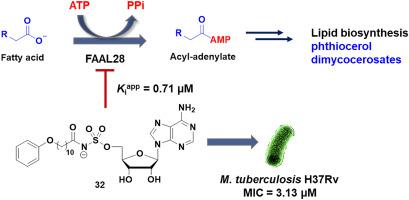European Journal of Medicinal Chemistry ( IF 6.0 ) Pub Date : 2020-06-13 , DOI: 10.1016/j.ejmech.2020.112408 Marzena Baran 1 , Kimberly D Grimes 2 , Paul A Sibbald 2 , Peng Fu 2 , Helena I M Boshoff 3 , Daniel J Wilson 2 , Courtney C Aldrich 4

|
Lipid metabolism in Mycobacterium tuberculosis (Mtb) relies on 34 fatty acid adenylating enzymes (FadDs) that can be grouped into two classes: fatty acyl-CoA ligases (FACLs) involved in lipid and cholesterol catabolism and long chain fatty acyl-AMP ligases (FAALs) involved in biosynthesis of the numerous essential and virulence-conferring lipids found in Mtb. The precise biochemical roles of many FACLs remain poorly characterized while the functionally non-redundant FAALs are much better understood. Here we describe the systematic investigation of 5′-O-[N-(alkanoyl)sulfamoyl]adenosine (alkanoyl adenosine monosulfamate, alkanoyl-AMS) analogs as potential multitarget FadD inhibitors for their antitubercular activity and biochemical selectivity towards representative FAAL and FACL enzymes. We identified several potent compounds including 12-azidododecanoyl-AMS 28, 11-phenoxyundecanoyl-AMS 32, and nonyloxyacetyl-AMS 36 with minimum inhibitory concentrations (MICs) against M. tuberculosis ranging from 0.098 to 3.13 μM. Compound 32 was notable for its impressive biochemical selectivity against FAAL28 (apparent Ki = 0.7 μM) versus FACL19 (Ki > 100 μM), and uniform activity against a panel of multidrug and extensively drug-resistant TB strains with MICs ranging from 3.13 to 12.5 μM in minimal (GAST) and rich (7H9) media. The SAR analysis provided valuable insights for further optimization of 32 and also identified limitations to overcome.
中文翻译:

结核分枝杆菌中脂肪酰基-AMP 和脂肪酰基-CoA 连接酶小分子抑制剂的开发。
结核分枝杆菌( Mtb ) 中的脂质代谢依赖于 34 种脂肪酸腺苷酸化酶 (FadD),这些酶可分为两类:参与脂质和胆固醇分解代谢的脂肪酰基辅酶 A 连接酶 (FACL) 和长链脂肪酰基 -AMP 连接酶 (FAAL) )参与结核分枝杆菌中发现的多种必需脂质和赋予毒力的脂质的生物合成。许多 FACL 的精确生化作用仍然知之甚少,而功能上非冗余的 FAAL 则得到了更好的理解。在这里,我们描述了 5'- O- [ N- (烷酰基)氨磺酰基]腺苷(烷酰基腺苷单氨基磺酸盐,烷酰基-AMS)类似物作为潜在多靶点 FadD 抑制剂的系统研究,其抗结核活性和对代表性 FAAL 的生化选择性和 FACL 酶。我们鉴定了几种有效的化合物,包括 12-叠氮十二酰基-AMS 28 、11-苯氧基十一酰基-AMS 32和壬氧基乙酰基-AMS 36 ,对结核分枝杆菌的最低抑制浓度 (MIC) 范围为 0.098 至 3.13 μM。化合物32以其对 FAAL28(表观K = 0.7 μM)与 FACL19( K > 100 μM)的令人印象深刻的生化选择性而闻名,并且对一组多药和广泛耐药结核菌株具有均匀的活性,MIC 范围为 3.13 至 12.5基本 (GAST) 和丰富 (7H9) 培养基中的 μM。 SAR 分析为进一步优化32提供了宝贵的见解,并确定了需要克服的局限性。











































 京公网安备 11010802027423号
京公网安备 11010802027423号